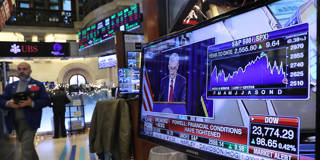Given that the US Federal Reserve has long said that its interest-rate policy is “data dependent,” why has it pressed ahead with monetary tightening in the face of worsening economic indicators? Three reasons stand out.
CAMBRIDGE – Earlier this month, the US Federal Reserve’s policy-setting Federal Open Market Committee (FOMC) voted unanimously to increase the short-term interest rate by a quarter of a percentage point, taking it from 2.25% to 2.5%. This was the fourth increase in 12 months, a sequence that had been projected a year ago, and the FOMC members also indicated that there would be two more quarter-point increases in 2019. The announcement soon met with widespread disapproval.
Critics noted that economic growth has slowed in the current quarter and that the Fed’s preferred measure of inflation (the rate of increase of the price of consumer expenditures) had fallen below the official 2% target. Given that the Fed has long said that its interest-rate policy is “data dependent,” why did it press ahead with its previously announced plan to continue tightening monetary conditions?
The FOMC statement announcing the latest interest-rate hike gave no explicit reason for it. Fed Chair Jay Powell’s remarks at his press conference also gave no reason for maintaining the originally planned rate increase despite the economic slowdown.

CAMBRIDGE – Earlier this month, the US Federal Reserve’s policy-setting Federal Open Market Committee (FOMC) voted unanimously to increase the short-term interest rate by a quarter of a percentage point, taking it from 2.25% to 2.5%. This was the fourth increase in 12 months, a sequence that had been projected a year ago, and the FOMC members also indicated that there would be two more quarter-point increases in 2019. The announcement soon met with widespread disapproval.
Critics noted that economic growth has slowed in the current quarter and that the Fed’s preferred measure of inflation (the rate of increase of the price of consumer expenditures) had fallen below the official 2% target. Given that the Fed has long said that its interest-rate policy is “data dependent,” why did it press ahead with its previously announced plan to continue tightening monetary conditions?
The FOMC statement announcing the latest interest-rate hike gave no explicit reason for it. Fed Chair Jay Powell’s remarks at his press conference also gave no reason for maintaining the originally planned rate increase despite the economic slowdown.